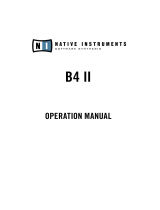TABLE OF CONTENTS
IMPORTANT NOTES ............................................................................................................................................................. 2
Product Care ......................................................................................................................................................................... 2
Notes about this manual ....................................................................................................................................................... 2
INTRODUCTION ..................................................................................................................................................................... 3
Main features ........................................................................................................................................................................ 3
FRONT PANEL ....................................................................................................................................................................... 4
Upper panel .......................................................................................................................................................................... 4
Side panels ........................................................................................................................................................................... 6
REAR PANEL ........................................................................................................................................................................ 10
MAKING CONNECTIONS ................................................................................................................................................... 13
Connecting to audio devices ............................................................................................................................................... 13
Connecting to MIDI devices ................................................................................................................................................ 15
Using a computer ................................................................................................................................................................ 16
Using a portable audio player ............................................................................................................................................. 17
Connecting pedals .............................................................................................................................................................. 17
SWITCHING ON AND BASIC FUNCTIONS ...................................................................................................................... 19
Sound engine structure ....................................................................................................................................................... 19
Organ models ..................................................................................................................................................................... 20
What are drawbars and how to use them ........................................................................................................................... 21
What are Presets and how to use them .............................................................................................................................. 24
Percussion .......................................................................................................................................................................... 25
Adding internal noises......................................................................................................................................................... 26
Vibrato and Chorus ............................................................................................................................................................. 26
Reverb ................................................................................................................................................................................ 27
Rotary / Amp ....................................................................................................................................................................... 27
Effects ................................................................................................................................................................................. 28
PROGRAM MAIN PAGE ...................................................................................................................................................... 29
What is a Program .............................................................................................................................................................. 29
Saving a Program ............................................................................................................................................................... 30
EDIT MENU ........................................................................................................................................................................... 31
UP/LO/PD DESTINATION section ...................................................................................................................................... 32
TW VIBRATO/CHORUS section ......................................................................................................................................... 32
EFFECT section ................................................................................................................................................................. 33
ROTARY / AMP section ...................................................................................................................................................... 35
REVERB section ................................................................................................................................................................. 36
PRESETS section ............................................................................................................................................................... 36
PERCUSSION section ........................................................................................................................................................ 37
MANUALS section .............................................................................................................................................................. 37
PEDALBOARD section ....................................................................................................................................................... 38
GENERAL SETTINGS MENU ............................................................................................................................................. 40
TUNE section ...................................................................................................................................................................... 40
EQUALIZER section ........................................................................................................................................................... 41
PREAMP AO-28 section ..................................................................................................................................................... 41
TW HUM section ................................................................................................................................................................. 42
AUX OUT section ............................................................................................................................................................... 42
AUX IN section ................................................................................................................................................................... 42
PEDAL SETUP section ....................................................................................................................................................... 42
MIDI section ........................................................................................................................................................................ 44
PROGRAM RECALL section .............................................................................................................................................. 45
UTILITY MENU ..................................................................................................................................................................... 46
SAVE ALL / SAVE PROGRAM / SAVE PRESETS functions ............................................................................................. 47
LOAD ALL / LOAD PROGRAM / LOAD PRESETS functions ............................................................................................. 48
FACTORY RESET function ................................................................................................................................................ 48
RELEASE / UPDATE function ............................................................................................................................................ 49
APPENDIX ............................................................................................................................................................................. 50
Error messages .................................................................................................................................................................. 50
Panic function ..................................................................................................................................................................... 51
Troubleshooting .................................................................................................................................................................. 51
MIDI Informations ........................................................................................................................................................... MIDI - 1






















